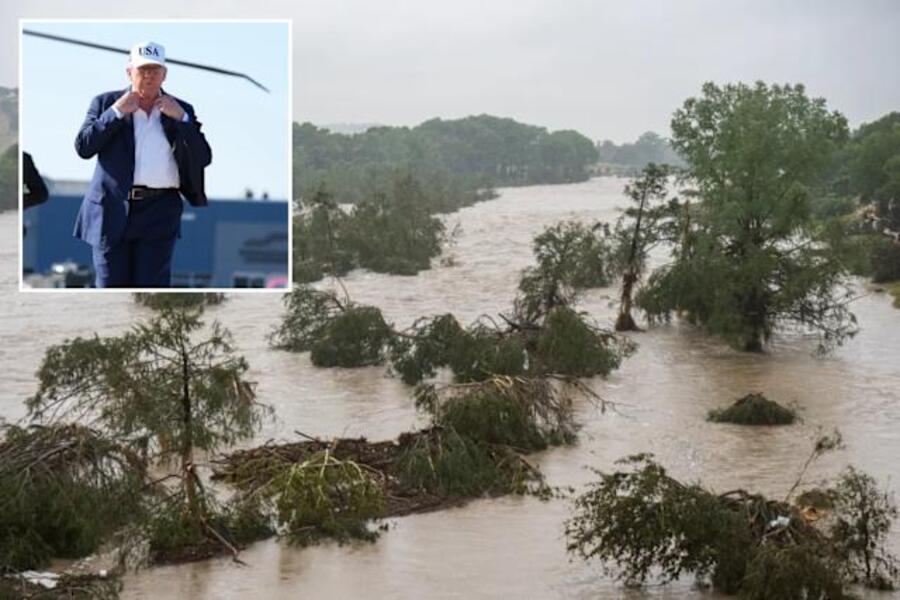President Donald Trump announced plans to visit flood-stricken Central Texas on Friday, following last week’s catastrophic flash floods that have left at least 104 people dead, making it one of the deadliest natural disasters in recent Texas history.
The president confirmed the visit during a briefing with reporters on Monday evening, describing the floods as a “terrible event.” He previously stated on Sunday that while he wished to visit sooner, he had postponed his trip out of respect for rescue and recovery efforts, noting, “I didn’t want to be in their way.”
What Happened: A Rapid and Deadly Deluge
The disaster began in the early hours of July 4, when historic rainfall hit Central Texas, triggering a violent and sudden rise of the Guadalupe River—by 25 feet in just 45 minutes around 4:30 a.m.. The speed and intensity of the flooding overwhelmed communities across Kerr County, where at least 84 of the confirmed fatalities have occurred. The tragedy has been particularly devastating for Camp Mystic, a girls’ summer camp near the river, where 27 children and staff are confirmed dead and several remain missing.
The scale of the disaster now surpasses that of Hurricane Harvey in terms of direct fatalities within Texas. Harvey, which struck in 2017, was previously considered one of the most destructive storms in U.S. history, with 68 direct deaths in the state and more than $150 billion in damages.
Why It Matters: Federal Response, System Gaps, and Staffing Concerns
In response to the crisis, President Trump signed a major disaster declaration for the region last week, unlocking federal funds for emergency aid, recovery assistance, and infrastructure rebuilding. The declaration was welcomed by state and local leaders, though questions about preparedness and systemic shortfalls have emerged in its wake.
A CBS News investigation into the flood response revealed that the National Weather Service (NWS) issued at least 22 emergency weather alerts for Kerr County and the surrounding Kerrville area in the hours leading up to the disaster. The warnings were part of an extensive effort by the NWS San Antonio office, which reportedly had increased staffing ahead of the storm.
Despite this, Tom Fahy, legislative director for the National Weather Service Employees Organization, raised concerns about chronic under-resourcing. According to Fahy, vacancy rates at both the San Antonio and San Angelo NWS offices were double what they were in January 2025, when Mr. Trump began his second term. Notably, the warning coordination meteorologist position in San Antonio—critical for real-time public communication during severe weather—was vacant as of July 4, the day the floods struck.
These revelations have fueled renewed debate over the federal government’s role in supporting meteorological infrastructure and ensuring robust disaster preparedness nationwide.
When pressed by reporters on Sunday about whether his administration’s staffing policies affected the NWS’s effectiveness, Mr. Trump simply responded, “They didn’t.”
What’s Next: Recovery, Investigation, and Political Fallout
President Trump’s upcoming visit is expected to include meetings with state emergency officials, a tour of the affected areas, and possibly remarks to the media addressing both the disaster and the administration’s ongoing recovery efforts.
In parallel, federal and state agencies continue their work on search-and-rescue operations, damage assessments, and long-term relief planning. The tragedy has also sparked calls from lawmakers and public safety advocates for increased federal investment in flood warning systems, staffing for critical weather positions, and modernization of early alert infrastructure—especially in flood-prone areas like the Guadalupe River Basin.
Public scrutiny is likely to intensify in the coming weeks, especially as families of the victims seek answers about whether this unprecedented loss of life could have been mitigated.
User Intent Breakdown
What happened?
Torrential rains caused deadly flash flooding in Central Texas, killing over 100 people, with Kerr County hit hardest.
Why is this significant?
It’s now deadlier than Hurricane Harvey in Texas. Staffing gaps at the National Weather Service may have affected warning systems, raising accountability questions.
What is being done?
President Trump signed a disaster declaration and plans to visit Friday. Search and rescue operations and investigations into emergency preparedness are underway.
What’s next?
Recovery efforts will continue, and there may be policy changes or hearings regarding meteorological staffing and federal disaster readiness.


